Celebrating This Special Month – and Its Future
A few thoughts of appreciation and serious consideration as we celebrate National Home Care, Hospice and Palliative Care Month:
These specialties are not only the foundation of my profession, they have a very personal connection for me. In 2013, I lost my wife Paula to non-Hodgkin’s lymphoma after a long battle. She was only 51.
Had it not been for palliative care, Paula would not have received help with pain and symptoms at home. She didn’t want to give up trying curative treatments. She didn’t have a six-month prognosis from her oncologist. So home-based palliative care provided some of the physical, emotional and spiritual relief Paula needed before she was “eligible” for hospice care.
Palliative care also paved the way for Paula to become a hospice patient. As her condition worsened, she eventually signed on for hospice care from the same agency she had grown to trust. She died peacefully in a beautiful hospice house where family and friends were able to gather and say goodbye.
Even though I’d been working in this business for more than a decade at that point, my experience with Paula took my respect for providers to a whole new level. The profound passion and compassion. The genuine respect for a person’s dignity. The willingness to go above and beyond to enhance the highest levels of comfort and quality of life as possible. I thank you all from the depths my heart.
As we look to the future in these uncertain times, I want to share three insights I’ve learned from my now 20-year stretch of supporting those who care for patients and families during the challenges of serious illness. Because I am one of millions who want to see providers succeed in their invaluable work.
 1. Patients and families need and want you more than ever.
1. Patients and families need and want you more than ever.
A recent national survey by Transcend Strategy Group (my company!) revealed that COVID-19 has dramatically changed 65% of family caregivers’ opinions about the best way to care for aging seniors. The biggest change is an overwhelming preference for home-based care instead of care in a facility. 60% say they are more confident quality care now can be provided in the home. 38% say they are more likely to use in-home care services. 51% say they are less likely or definitely won’t use in-facility care if they have a choice.
In addition to the outstanding care you provide for patients, family caregivers will continue to crave your support at an increasingly higher volume. A study reported by Reuters in 2017 revealed:
- By 2020, over 100 million Americans will need care assistance (recent data shows we’ve indeed hit that mark).
- By 2030, there will be a national shortage of 151,000 paid direct care workers, resulting in 3.8 million unpaid family caregivers spending significant time to provide care,
- By 2040, that shortage of paid care workers will increase to 355,000 with 11 million unpaid family caregivers picking up the slack.
The passion and purpose that drive you will become more important than ever as patients and families alike will lean heavily on your expertise.
 2. Recruiting and retaining qualified staff members will continue to be a struggle.
2. Recruiting and retaining qualified staff members will continue to be a struggle.
The numbers above predict that the challenges you’re already facing with staffing will likely become even greater. COVID-19 has intensified the competition for RNs in virtually every market. CNAs and home care aides are often in short supply. Turnover rates are notoriously high as trained and talented workers jump ship for a different opportunity or burn out from healthcare altogether.
Yet many dedicated team members stay because of their passion for their work. Many describe it as a “calling” rather than a career. It’s incumbent on home care, hospice and palliative care leaders to make sure their agency’s mission, purpose and values are crystal clear. It’s vitally important to explain the “why” of what you do, every day – then support those initiatives with actions. Most team members will stay put and give their very best for a purpose they believe in and find personally fulfilling. And more prospects will be attracted to a purposeful “calling” from other areas of the healthcare spectrum.
 3. Innovations and partnerships are key to surviving and thriving.
3. Innovations and partnerships are key to surviving and thriving.
As the healthcare landscape and reimbursement models continue to shift (sometimes drastically, as with PDGM in home health), so must providers change with the times.
As payers reconfigure the rules of reimbursement – often reducing rates – providers must constantly innovate to provide efficiencies without sacrificing quality of care. Telehealth and other virtual care tools are one frontier of innovation that has promising potential for maximizing resources and delivering both quality and equality of care, even in remote areas of our country. And payers must be willing to innovate and compromise, as CMS did recently in relaxing restrictions and approving reimbursement for certain tasks conducted by telehealth.
In addition, no single provider can really deliver on the full continuum of care alone, even when focused on only the seriously ill population. Partnerships among providers of pre-acute care, acute care and post-acute care must collaborate to help each provider concentrate on their specialties and refer to their trusted partners at appropriate times. Models such as managed care and Accountable Care Organizations will continue to be driven by payers with a goal of delivering truly value-based, patient-centered care. How can you be more proactive in advancing such partnerships in your service area?
As you consider and act on these factors, I wish your agency all the best for achieving new levels of success. Because my heart’s desire is that your team not only survives but thrives in the future so you can be there for families like my local provider was there for Paula and me. And we can all celebrate National Home Care, Hospice and Palliative Care Month for decades to come. If you want to talk through how these considerations impact your strategies and communications, Transcend would be honored to help. Email me anytime at [email protected].









